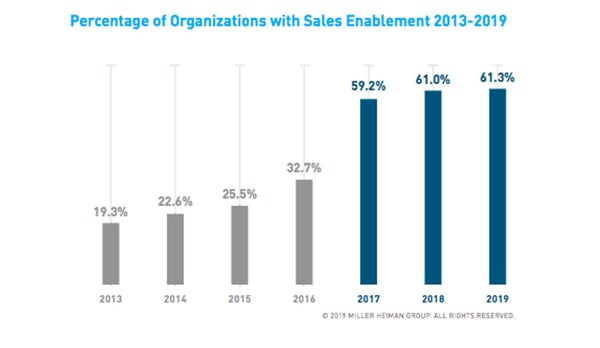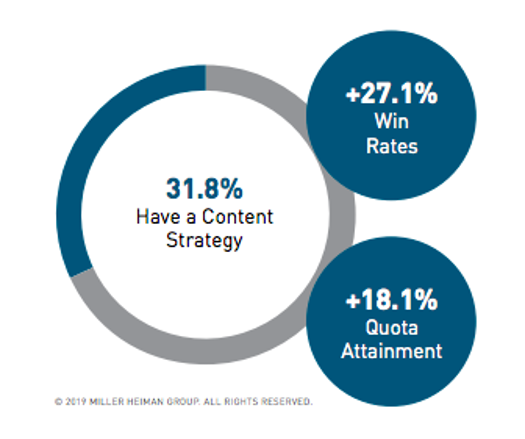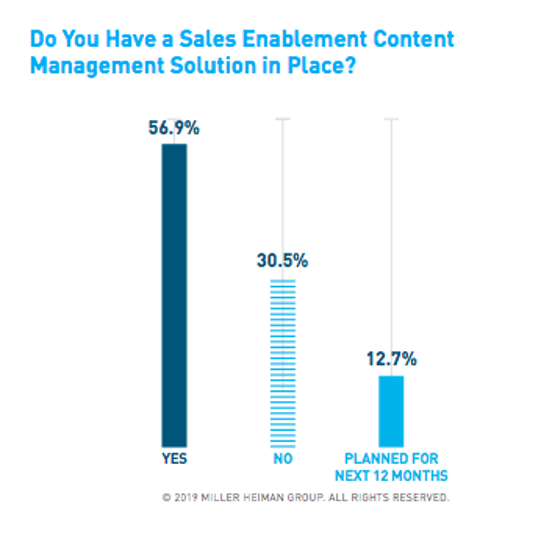The Customer Connection: How QorusDocs Relationship Managers Help Teams Work Smarter and Win More
Like many other facets of business, sales enablement is evolving rapidly thanks to technology.
In the Fifth Annual Sales Enablement Study by CSO Insights, we see a wealth of interesting statistics and insights that show us what sales enablement looks like today.
Here’s a quick summary of some of the most fascinating research findings.
- The percentage of organizations using sales enablement is growing
As the graph below shows, only 19% of organizations were using sales enablement in 2013. After a few small jumps year on year, there was a big spike that took the number of organizations using sales enablement up to 59% in 2017.
Although the growth has been slower since then, there has still been an increase in the percentage – and now, more than 60% of organizations are using sales enablement.
Source: Fifth Annual Sales Enablement Study - One-third of organizations are still missing out on the competitive edge
Although the study reveals that the majority of organizations are now using sales enablement, there’s still a large percentage that (39%) that remain without this competitive advantage.
A key factor appears to be the size of the organization: 77% of companies with a sales force of over 500 people have dedicated sales enablement in place. On the other hand, only 39% of those with 25 or fewer salespeople can say the same. - Alignment to the customer journey has a way to go
We know that the buyer is increasingly in control and that, as a result, organizations need to take a customer-centered approach and should align their enablement services to the appropriate phase of the customer’s purchasing journey. Interestingly, the study shows that even though the majority of organizations (52%) align their sales processes to the customer’s path, only 31% align their enablement services to the customer’s journey.

Source: Fifth Annual Sales Enablement StudyAs we see in the report, enablement is where services should be aligned to the customer’s journey, but it requires close collaboration with sales operations, marketing, and customer experience.
- There's room to improve enablement content
The study showed that only about one third (32%) of respondents have a content strategy in place. Even though the reality is that having one leads to higher win rates and quota attainment as the image below shows.

Source: Fifth Annual Sales Enablement Study
Another benefit of a clearly defined sales enablement strategy is that it creates better synergy between sales and marketing teams. This helps marketers develop content that they know will help salespeople close more deals.The report suggests that, once a sales enablement content strategy is in place, the next step is to assess the effectiveness by content type. Understanding how the sales team is using content to drive sales and close deals is vital to closing the loop and ensuring that you are creating the right materials for them.
- Using the right technology matters
Despite the fact that advanced sales enablement technologies exist, we see from the report that 43% of the organizations still share content with their sales teams via email or that they store it in various disparate repositories. And, this percentage hasn’t changed much compared to last year (48%). The report also found that 43% of organizations are still not using a sales enablement content management solution (with 13% of those planning to introduce one in the next 12 months).

Source: Fifth Annual Sales Enablement Study
Having multiple sources of content creates frustration among salespeople and makes it extremely difficult for content managers to effectively introduce and manage a content strategy.
How can a sales enablement platform, like Qorus, help you win more business?
A well-planned and smoothly run sales enablement process can have a profound effect on your organization’s ability to differentiate itself and win business. And, using the right sales enablement platform can help you drive the process forward successfully.
After all, clear, relevant, and personalized sales content – that is tailored to each touchpoint – is key to building and maintaining relationships with prospects over the course of your sales process. It enables you to educate, consult, and address objections.
The faster this happens, the shorter your sales cycle and the higher your win rate. But, finding and sharing content with prospects can be a frustratingly slow process.
This is why we created the Qorus sales enablement platform: to help sales teams quickly find the content they need to get to market fast and close more deals. Qorus is a sales enablement platform with a content library that users can access directly from their Office applications.
FOR MORE ON SALES ENABLEMENT FOR WINNING TEAMS, WATCH:

February 11, 2020


